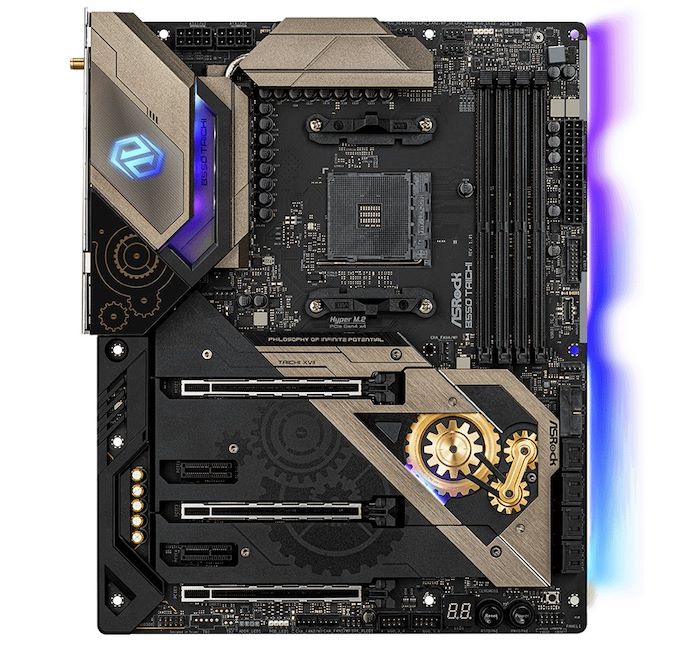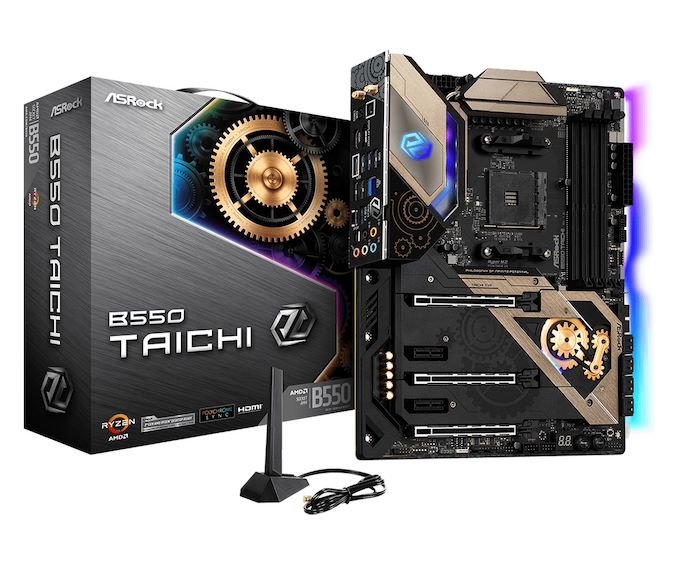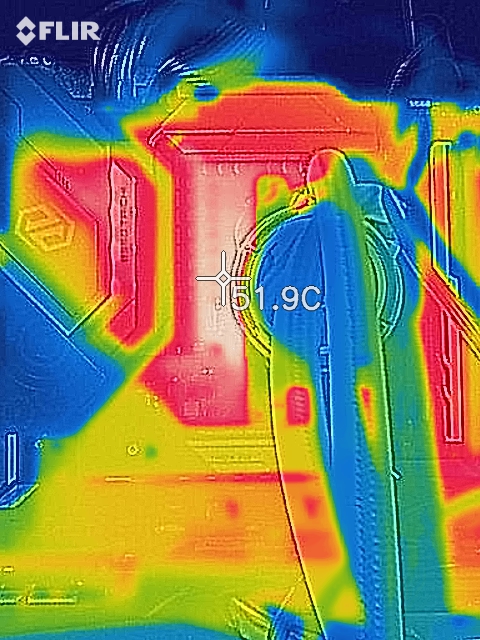ASRock B550 Taichi Review: The $300 B550 Motherboard with Chutzpah
by Gavin Bonshor on August 21, 2020 3:30 PM EST- Posted in
- Motherboards
- AMD
- ASRock
- Taichi
- AM4
- Ryzen 3000
- Ryzen 3700X
- Ryzen 4000
- B550
- B550 Taichi
_678x452.jpg)
Outside of its Aqua series of motherboards, which come with exquisitely crafted monoblocks, ASRock's Taichi brand has been a critical part of the company's offerings in the land of premium motherboards. The ASRock B550 Taichi sits at the top of its product stack and features an impressive quality feature set. Some of the most notable features include a large 16-phase power delivery, eight SATA ports, dual M.2 slots, an Intel 2.5 GbE Ethernet controller, and an Intel Wi-Fi 6 interface. At $300 it comes equal in price with the X570 version, which leaves questions on the table as to which one is actually worth the money.
When AMD first released the B550 chipset, a lot of fanfare was made about the high launch price of some models. For what has been usually considered a 'budget' chipset, some of the more premium B550 models cost more than some of the X570 models, which featured full support for PCIe 4.0 to add-in cards and the chipset. The B550 chipset has less PCIe 4.0 support than X570, with only the top full-length PCIe slot and one PCIe M.2 slot operating at PCIe 4.0, while the rest of the slots and chipset operate at PCIe 3.0. The trade-off is downstream bandwidth from the chipset as well as power, because the X570 requires a fan to keep that PCIe 4.0 chipset cool. Ultimately X570 requires 'more' to be fully enabled than B550, so it comes as a bit of surprise when the B550 and X570 models sit on equal pricing.
The ASRock B550 Taichi
Even with what has been said above, the ASRock B550 Taichi has all the hallmarks of a premium AM4 model with a solid array of controllers, ports, and power delivery.
Armed with its unique Taichi inspired design, the ASRock B550 Taichi follows a bronze and black color scheme with three customizable RGB LED zones. ASRock has installed the B550 Taichi with a large sixteen phase power delivery, which performs very well in our thermal testing. Unique to the ASRock range, the B550 Taichi is the only board where the top two PCIe slots support a PCIe 4.0 x8/x8 configuration - out of all other B550 boards, only two others have this feature.
Another solid benefit of the Taichi is that it includes a BIOS Flashback controller which allows users to update the firmware without a CPU installed. This is useful for when AMD launches Ryzen 4000 and a firmware update will be required to use the new Zen 3 processors. Some of the board's other core features include 2.5 GbE networking, Wi-Fi 6, and a premium audio codec with an assisting amplifier designed to bolster the quality of the front panel audio header.
After running our benchmarking suite, the ASRock B550 proved a consistent and solid performer in our testing. It displayed competitive performance in our system tests with strong power consumption figures in all three of our power tests, with a decent non-UEFI POST time of 20.6 seconds at default settings. In our CPU and gaming tests, the B550 Taichi performed competitively against other AM4 boards tested with our testbed Ryzen 7 3700X processor.
Our overclocking testing proved resourceful with a maximum stable overclock of 4.3 GHz with our Ryzen 7 3700X processor. Overall VDroop control was consistent throughout our testing, as was the performance in our POV-Ray benchmark testing. We saw equally impressive performance in our VRM thermal testing with the Taichi beating some of the more advanced and much more expensive X570 models. This is due to a more efficient power delivery design, as well as a solid pair of heatsinks which are interconnected via a single heat pipe for better heat dissipation. This is ultimately the reason why, despite being B550, this Taichi costs the same as the X570: better thermals and better power delivery.
The ASRock B550 Taichi as it stands is one of the most expensive B550 models with an MSRP of $300. This puts it up against ASRock's own X570 Taichi which currently costs $300 at Newegg. This puts the B550 Taichi in an awkward position in terms of value, with the X570 offering more raw features. However the B550 Taichi offers an alternative is the slightly larger power delivery (16-phase versus 14-phase), and an Intel 2.5 GbE Ethernet controller whereas the X570 Taichi is equipped with a standard Gigabit port.
Read on for our extended analysis and comparison tests.













61 Comments
View All Comments
Irata - Saturday, August 22, 2020 - link
You also have x4 PCIe 4.0 plus several USB ports connected directly to the CPU with Ryzen. There is an Aorus board that allows the x8 plus three times x4 for nVME connection all directly from the CPU.If the Ampere and RDNA2 only need the bandwidth provider by 8x PCIe 4 / 16x PCIe 3, you can run the GPU and three nVME at full speed that way, plus USB devices connected to the CPU *and* still have the x4 PCIe 3 lanes for the chipset to CPU connection for everything else on B550.
I'd say this is where Ryzen 2 and 3 shine vs the competition that is much more limited with PCIe 3 and four fewer lanes from the CPU.
Death666Angel - Saturday, August 22, 2020 - link
I'm curious, what would be your use case for two x8 slots? Multi GPU is dead and are there any peripheral cards that need an x8 slot from the CPU? :)MrVibrato - Sunday, August 23, 2020 - link
There are x8 HBAs / RAID controllers.So, if one wants to use a GPU and such a HBA / RAID controller, two available x8 slots can make sense...sandtitz - Friday, August 21, 2020 - link
"...and the slightly older Intel AX200 [vs AX201]"According to Intel ARK, they're both the same product, released at the same time. Only the system connectivity differs.
No reason to prefer either.
invinciblegod - Friday, August 21, 2020 - link
What does system connectivity mean?dotes12 - Friday, August 21, 2020 - link
I think that Intel's AX200 does Wi-Fi through PCI-E and Bluetooth through USB, while Intel's AX201 uses CNVi for both in one CNVio link. I might have the 200/201 numbers reversed, but that's the idea as far as I understand it.Hyoyeon - Friday, August 21, 2020 - link
CNVi (intel proprietary) modules are often soldered, so I prefer the AX200.jabber - Saturday, August 22, 2020 - link
I must admit for me the PCIe slot setup I'd prefer is1 x 16
4 x 4
More practical for my use. Boards come with way too many 16 and 1 slots for my liking. The x4 slot is underappreciated.
Gigaplex - Saturday, August 22, 2020 - link
x4 cards fit in an x16 slot. There's not really much benefit in putting a physical x4 slot on the board - may as well just put an x16 slot and have it share lanes with some of the other slots, dropping down to x4 active.jabber - Monday, August 24, 2020 - link
Ahhh well you see I want to just have SET slots. I don't want that "if X is in Y then V is x4 or disabled and if Y is in V then C is X16 and if X is in V then its x8 but if you have NVMe in Slot B its disabled" nonsense.